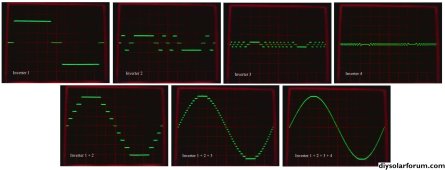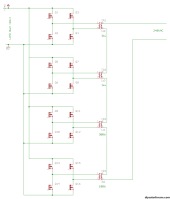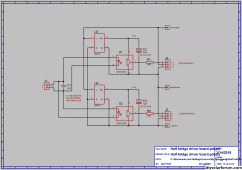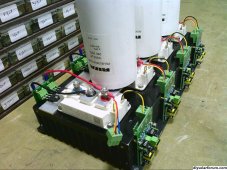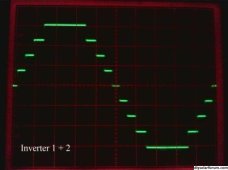I was going to say, "But they are in series, carry the same current."
Then, glancing at the schematic, I realized secondary windings are what's in series. Due to turns ratios, primary all carry different current.
You said 3 levels not two; each is MSW not square wave. How do you drive the FETs for shorted winding rather than driven positive or negative polarity of battery? You did indicate FETs happily conduct current either direction when on so I'm guessing two pull downs or pull ups.
You show a dead time of 1 microsecond +/- set by cap across LED of optoisolator. Does an inductive kick appear when FETs are off?
What is no-load current through primaries of transformers?
There are quite a few hidden features in all of this, that may not be immediately obvious.
Firstly its not too difficult to see how switching the primaries generate the required three level rectangular voltage waveforms in the secondaries, and how the series connected secondaries all add these together directly, to generate a very low distortion sine wave output voltage.
The measured THD is 0.85% and the strongest harmonic is the third which is down -40db.
What may be less obvious, is that the sine wave current in the secondaries will be continuous and equal in each secondary, and that will be reflected back into the primaries as a constant unbroken sine wave current, regardless of what the mosfets/IGBTs are doing !
Think of these as four square wave voltage transformers in the forward direction, and four sine wave current transformers in the reverse direction.
That is rather odd, but its how this all actually works.
I know this is all a rather difficult concept to get your head around to begin with, but please try to bear with me....
Because of this continuous sinusoidal primary current, the zero volt output state requires a shorted out primary winding, because current must continue to flow when a particular transformer is outputting zero volts.
Each primary is driven by four IGBTs (or sometimes mosfets) in a conventional hard switched bridge configuration. Diagonal IGBTs are turned on to switch battery voltage direct across the primary in the usual way.
To short out the primary, during the zero volt part of the waveform, we can turn on either both lower IGBTs together, OR both upper IGBTs together.
It does not really matter, the result will be the same either way.
The half bridge driver boards each drive one upper and one lower IGBT on one side of each bridge. Opto isolators are used, but the opto isolator LEDs are connected in inverse parallel, so its impossible for both opto isolators to be on together. This feature reliably prevents any shoot through problem, where upper and lower IGBT might conduct simultaneously. By adding some capacitance across the opto LEDs, that generates reliable and symmetrical dead time.
All of these features combine to make for a very robust switching bridge that is extremely immune from noise, or corrupted data that may occur during power up or power down, or brownout. Its the secret to designing very robust inverters that do not randomly blow up !
Data comes from the control board over a balanced low impedance twisted pair, that is opto isolated at the far end. This provides extremely high noise immunity and the twisted pairs can be made quite long without any worries about picking up noise. That can be rather important at very high power levels.
One data bit controls one side of the bridge. Logic 0 is lower IGBT on, Logic 1 is upper IGBT on. Always one or the other is on, except during dead time. There are four possible logic drive states to each bridge 00, 01, 10, and 11. All are safe in the respect that corrupted data might put a momentary kink in the sine wave, but it cannot blow anything up.
So basically the whole of the four power switching stages are very well protected from noise or being driven with scrambled or corrupt data. This goes a very long way to designing a very reliable bullet proof inverter.
As far as no load idling current goes, my own 5Kw inverter draws 32 watts of total dc idling power. About five watts of that is for the control board, and the rest is just mostly transformer magnetizing current. Other Warpverters vary a bit, I think the record so far is about 20 watts of idling power for a 7Kw inverter. There is a bit of luck involved that concerns the quality of the core material used in the transformers. Some material is excellent, and some less so....
More on designing the transformers later.



